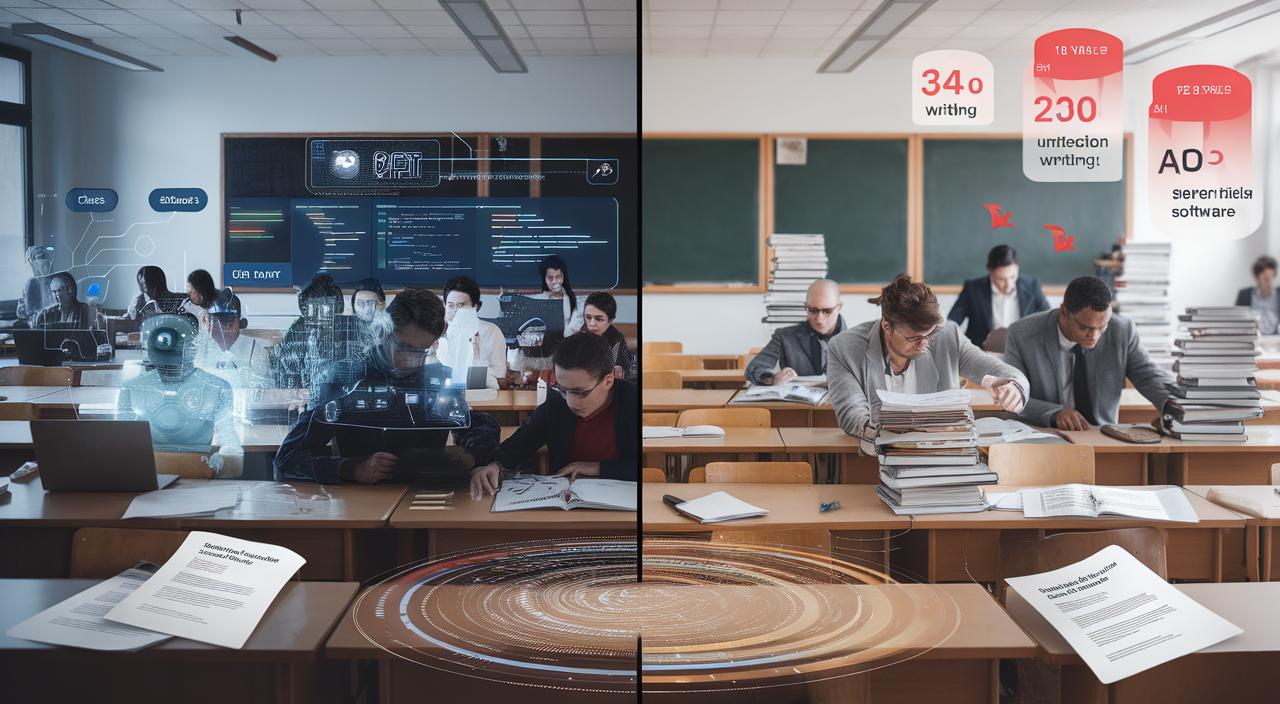The AI cheating scandal obsession in higher education has hit peak levels with 30% of college students using ChatGPT for schoolwork and 1 in 5 using AI for assignments or exams. This trend affects everything from academic integrity policies to teaching methods in colleges and high schools alike.
Key Takeaways
- Current AI detection tools like Turnitin and GPTZero lack reliability, creating problems with false positives that unfairly flag legitimate student work and false negatives that miss AI-generated content.
- Students commonly use AI for essay writing, coding assignments, math problem-solving, lab report generation, and online quiz assistance.
- Educational responses vary dramatically, from complete AI bans to progressive integration at institutions like Stanford and MIT.
- The focus on catching AI cheating has created unsustainable workloads for educators who must use time-consuming validation methods like interviews and draft reviews.
- Forward-thinking educators are adapting by implementing AI literacy programs, creating AI-compatible assignments, and developing clear guidelines for responsible AI use.
Problems with AI Detection Tools
Current AI detection tools simply don’t work well enough. I’ve seen firsthand how Turnitin and similar platforms wrongly accuse honest students while missing actual AI-written work. These false accusations damage student-teacher trust and create unnecessary stress for everyone involved.
How Students Are Using AI
Students have found multiple ways to use AI in their academic work. They’re generating essays, solving coding problems, completing math assignments, writing lab reports, and getting help with online quizzes. The technology has spread across all subjects and assignment types.
Institutional Responses
Schools have responded with wildly different approaches. Some institutions have banned AI tools completely, while others like Stanford and MIT actively encourage their use. This inconsistency leaves students confused about what’s acceptable as they move between courses or institutions.
The Burden on Educators
The obsession with catching AI cheaters has created an impossible burden for teachers. I now spend hours interviewing students about their work, reviewing drafts, and trying to authenticate authorship — time that should go toward actual teaching and mentoring.
A Shift Toward AI Integration
Smart educators are shifting their approach. Instead of fighting a losing battle against AI use, they’re teaching AI literacy, redesigning assignments to work with AI rather than against it, and establishing clear boundaries for appropriate AI assistance.
The AI Academic Arms Race: What the Data Actually Shows
Tracking the AI Cheating Scandal Obsession in Higher Education
The numbers paint a stark picture of how deeply AI has penetrated academic institutions. During the 2022-2023 academic year, Intelligent.com found that 30% of college students turned to ChatGPT for their schoolwork — a figure that’s sent shockwaves through academic circles, much like the sad girl dinner trend took over social media.
Students aren’t just experimenting with AI — they’re actively incorporating it into their academic routines. BestColleges’ research revealed that nearly 1 in 5 students have admitted to using AI for assignments or exams, highlighting how the AI cheating scandal obsession has become a serious concern for educators.
Breaking Down AI Usage Patterns
I’ve noticed that students are getting creative with AI applications across different subjects. Here are the most common ways students are using AI tools:
- Essay writing and paper development
- Coding assignments and debugging
- Math problem-solving and verification
- Lab report generation
- Online quiz assistance
This rise in AI usage mirrors other digital trends that quickly gain traction, similar to how the pastel food obsession swept through social platforms. The AI cheating scandal obsession isn’t limited to college campuses — high schools are facing similar challenges, creating a ripple effect throughout the education system.
The varying survey results on AI usage rates reflect the complex nature of this issue. While some studies show higher adoption rates in specific fields like computer science, others indicate widespread use across all disciplines. This pattern of tech adoption reminds me of how the oversized garnish obsession started in high-end restaurants before spreading to casual dining.
Student behaviors with AI tools often mirror broader cultural shifts, not unlike the sad bento box phenomenon. The AI cheating scandal obsession has transformed from isolated incidents into a widespread concern that’s reshaping academic integrity policies and teaching methods.
Why Educators Can’t Reliably Catch AI Cheating (And Why That Matters)
The AI Cheating Scandal Obsession: Detection Tools Fall Short
I’ve noticed how the current AI detection landscape faces serious challenges. Popular tools like Turnitin’s AI detector and GPTZero simply don’t deliver the reliability needed to make definitive calls about student work. Turnitin’s own documentation explicitly warns educators to treat AI detection scores as suggestions rather than concrete proof – a red flag that shouldn’t be ignored.
This tech limitation creates a domino effect of problems. Like perfectly arranged meals that mask underlying issues, these tools present a deceptively simple solution to a complex problem. The AI cheating scandal obsession has led to several documented cases where students faced false accusations, damaging trust between educators and learners.
Growing Concerns in Academic Assessment
The ripple effects of unreliable AI detection spread far beyond individual classrooms. Just as trends in meal posting can mask deeper social issues, the AI cheating scandal obsession reveals cracks in our academic assessment systems. Universities struggle to create consistent policies, leaving individual instructors to make judgment calls without reliable tools.
Here’s what makes current AI detection particularly problematic:
- High false positive rates flag legitimate student work as AI-generated
- False negatives fail to catch actual AI-written content
- Limited ability to distinguish between different AI writing tools
- Inconsistent results across different academic subjects
- No standardized thresholds for what constitutes “AI-generated” content
The pressure to catch AI cheating has created a situation similar to overdoing food presentation – focusing on surface-level solutions while missing the deeper issues. Like chasing aesthetic trends, the obsession with AI detection tools overshadows more fundamental conversations about modern assessment methods and academic integrity.
I’ve found that educators now carry an extra burden – they must validate potential AI use through time-consuming methods like student interviews and draft reviews. This creates an unsustainable workload while still not guaranteeing accurate results.
Beyond the Moral Panic: Rethinking Education in the AI Era
Understanding the AI Cheating Scandal Obsession
I’ve noticed how the AI cheating scandal obsession has dominated educational headlines, creating a wave of panic similar to the sad girl dinner trend that swept social media. Just as trends can spark unnecessary concern, the current fixation on AI cheating has led many institutions to implement rushed, restrictive policies.
The spectrum of institutional responses tells a complex story. Some universities have opted for complete AI bans, while others, like Stanford and MIT, are actively incorporating AI tools into their teaching methods. This divide mirrors other educational debates, much like the obsession with presentation over substance in academic work.
Moving Beyond the AI Cheating Scandal Obsession
The current AI cheating scandal obsession needs a balanced approach. Here’s what faculty surveys have revealed about effective AI integration:
- Implementation of AI literacy programs focused on ethical use
- Creation of assignment formats that leverage AI as a learning tool
- Development of clear guidelines for acceptable AI assistance
- Integration of AI tools like ChatGPT and Khanmigo in supervised settings
I’ve found that the conversation around AI in education often overlooks crucial equity issues, similar to how aesthetic trends can mask deeper problems. Not all students have equal access to AI tools, and detection technologies don’t work uniformly across different student populations.
The solution isn’t creating more restrictions but building better educational frameworks. Some forward-thinking educators are already adapting their teaching methods, treating AI as a tool for enhancement rather than a threat. This includes redesigning assignments to focus on critical thinking and analysis rather than pure content production.
Instead of letting the AI cheating scandal obsession dictate educational policy, I’m seeing more educators embrace proactive approaches. They’re teaching students how to use AI responsibly while maintaining academic integrity. This shift from punishment to education promises better outcomes for both students and institutions.
Colleges are increasingly struggling to maintain academic integrity amid the growing fear of classroom dishonesty, further fueled by rising cases of AI misuse in student assignments.
Sources:
Intelligent.com – “1 in 3 College Students Have Used ChatGPT for Schoolwork”
BestColleges – “College Students’ AI Tools Usage Statistics”
Turnitin – “AI Writing and the Challenge of Detection”
The Chronicle of Higher Education – “Caught Cheating With AI”
Inside Higher Ed – “Students Embrace AI Tools”
The Washington Post – “Professors AI Cheating”
Wired – “AI Detectors Student Cheating”








